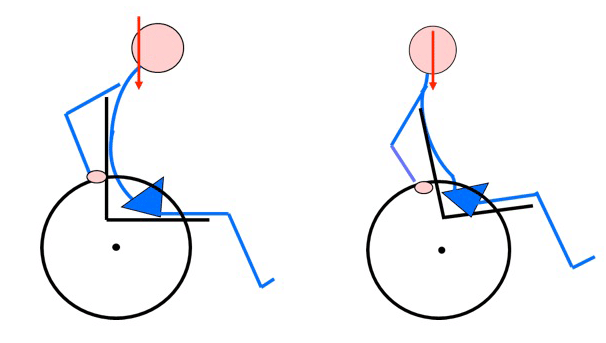Share:
Hello all!
This month, let's continue our focus on manual wheelchairs by looking at the effects of the vertical rear wheel position in manual wheelchairs. Both standard and folding wheelchairs allow for vertical positioning of the rear wheels. Positioning the rear wheel up or down the frame of a manual wheelchair will have effects on seat-to-floor height, orientation in space, and rear wheel access.
Seat-to-floor height
Rear seat-to-floor height is affected not only by the size of wheels used, but also by the height of the rear wheels relative to the frame. If we move the rear wheels up on the frame, we create a lower rear seat-to-floor height. If we move the rear wheels down on the frame, we create a higher rear seat-to-floor height.
Seat-to-floor height affects a number of things. Access to the environment is affected by seat-to-floor height. This includes being able to get under a desk or table and reach into cupboards. Transfers, such as standing pivot transfers or sliding board transfers, are affected by the seat-to-floor height of the wheelchair. For people who use one or both feet to propel, having the appropriate seat-to-floor height is important to ensure ease of propulsion while maintaining postural control.
Orientation in space
The difference in height between the front seat-to-floor height and the rear seat-to-floor height creates a fixed tilt, or "dump", in the wheelchair when the rear seat-to-floor height is lower than the front seat-to-floor height. As mentioned above, if the front seat-to-floor height remains unchanged, but the position of the rear wheel axle is moved up on the frame, lowering the rear seat-to-floor height, fixed tilt is created. We can also create fixed tilt through changing the front seat-to-floor height. This is done by leaving the rear seat-to-floor height unchanged, but using either a larger diameter caster, a longer fork or stem bolt, or using a lower hole in the fork, all of which create a higher front seat-to-floor height. The greater the difference in height between the front seat-to-floor height and the rear seat-to-floor height, the greater the angle of the seat plane, which can make transfers more difficult1 due to the effects of gravity when transferring out of the wheelchair.
Something to keep in mind is that any time changes are made to the rear wheel, front caster, or fork/stem bolt, the caster housing must be re-aligned to ensure that it is perpendicular to the ground. If the caster housing is not perpendicular to the ground, caster flutter can result. Caster flutter increases the effort required to propel and maneuver the wheelchair.
Recall from my previous article, More on Practical Seating Considerations – Posterior Pelvic Tilt, that fixed tilt in a wheelchair can use the effects of gravity to assist with postural control. For those who present with a kyphotic spine, the use of fixed tilt in a wheelchair improves the field of vision for those individuals by changing the orientation of the sight line. (See the aforementioned article for graphics that illustrate these concepts.)
Rear wheel access
The use of fixed tilt on a wheelchair not only affects postural control, but also access to the rear wheel for those who hand propel. The graphics below represent both the effects of fixed tilt on posture and the effects of fixed tilt on upper extremity position when accessing the pushrim. Notice that on the graphic on the left, the "shoulder" is in excessive extension and the "elbow" is in excessive flexion, putting the person at risk for upper extremity injury with the repetitive movements and forces required to propel the wheelchair. Changing the angle of the seat pan through fixed tilt improves the position of the upper extremity relative to the rear wheel, as shown in the graphic to the right.

Ideally, through the vertical and horizontal position of the rear wheel and through the choice of size of the rear wheel, we are trying to achieve 100 to 120 degrees of elbow flexion when the hand is at the top, centre position on the pushrim2. This position promotes effective, efficient propulsion and minimizes risk of upper extremity injury.
The vertical rear wheel position on a manual wheelchair is an important consideration as it affects seat-to-floor height, orientation in space, and access to the rear wheels.
References
- Rehabilitation Engineering & Assistive Technology Society of North America. (2012). RESNA Position on the Application of Ultralight Manual Wheelchairs. Downloaded from http://resna.org
- Consortium for Spinal Cord Medicine Clinical Practice Guidelines. (2005). Preservation of upper limb function following spinal cord injury: A clinical practice guideline for health-care professionals. Paralyzed Veterans of America.